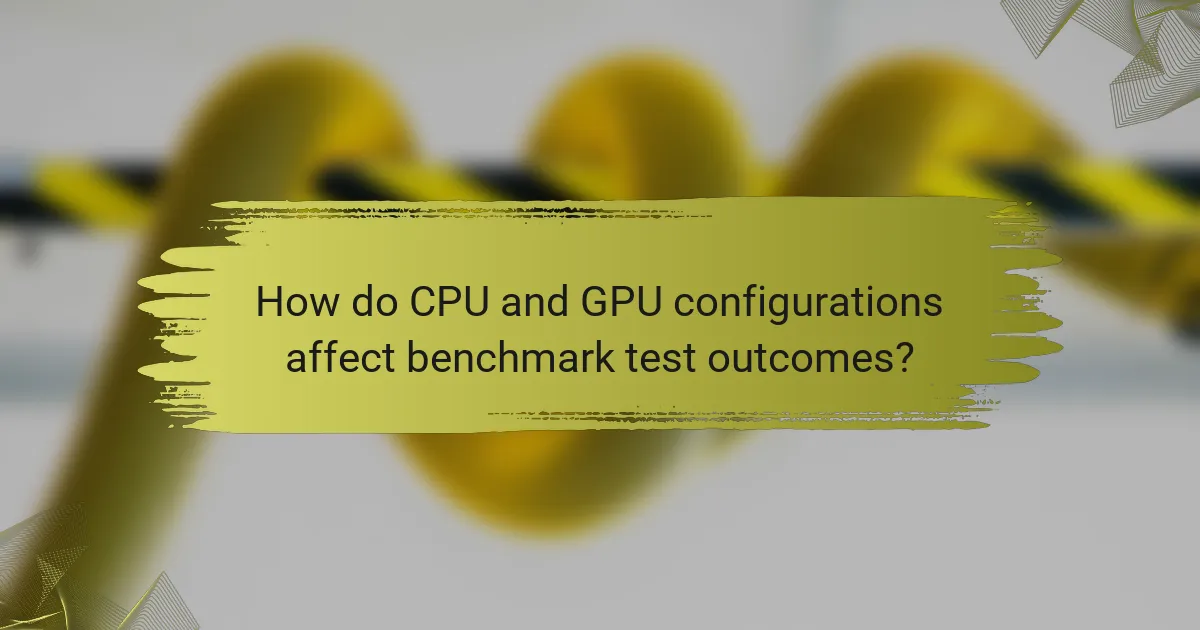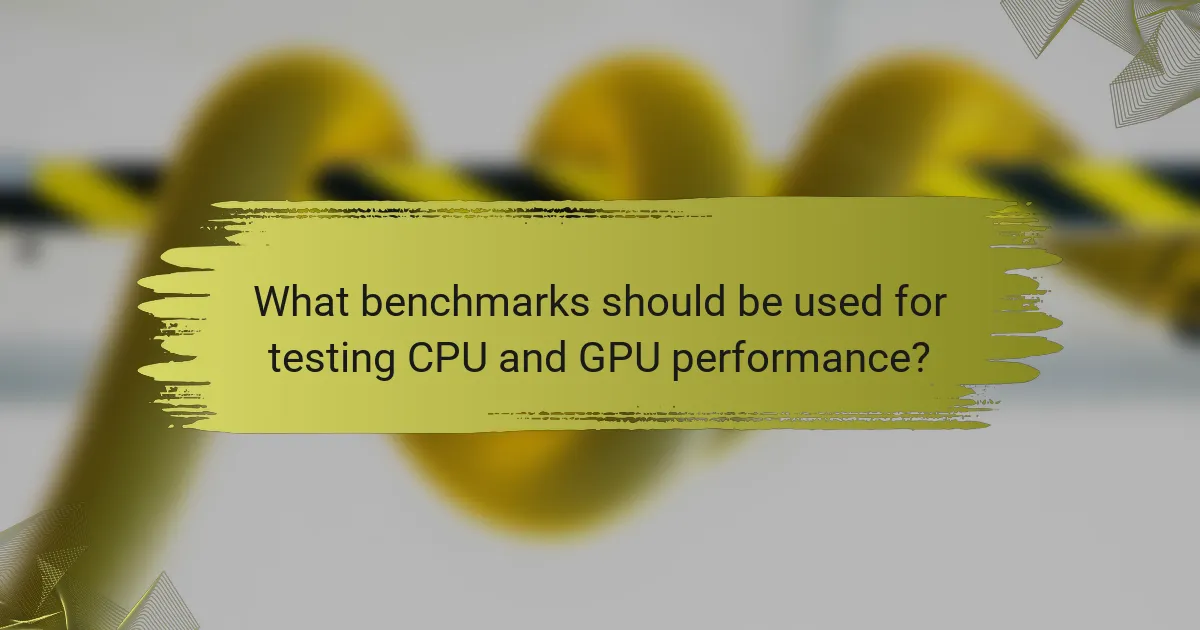CPU and GPU configurations play a crucial role in determining the performance outcomes of benchmark tests, as they affect data processing efficiency and graphics rendering capabilities. Factors such as clock speed, memory size, core count, and thermal management can lead to significant variations in performance across different scenarios, making the right combination essential for optimal results.

How do CPU and GPU configurations affect benchmark test outcomes?
CPU and GPU configurations significantly influence benchmark test outcomes by determining how efficiently a system can process data and render graphics. Key factors include clock speed, memory size, core count, and thermal management, all of which can lead to varying performance results in different testing scenarios.
Impact of CPU clock speed
The clock speed of a CPU, measured in gigahertz (GHz), directly affects how quickly it can execute instructions. Higher clock speeds generally lead to better performance in single-threaded tasks, while multi-threaded applications benefit from additional cores rather than just speed. For most modern CPUs, a clock speed range of 3.0 to 4.5 GHz is common.
When benchmarking, consider that a CPU with a higher clock speed may outperform one with a lower speed in tasks like gaming or basic applications. However, for heavy multitasking or professional workloads, core count may become more critical than clock speed alone.
Influence of GPU memory size
GPU memory size, or VRAM, plays a crucial role in how well a graphics card can handle high-resolution textures and complex scenes. A larger VRAM allows for better performance in demanding applications, especially in gaming and 3D rendering. Typical VRAM sizes range from 4GB to 16GB, with higher-end models offering even more.
When selecting a GPU for benchmarking, ensure that the memory size aligns with the intended use. For instance, gaming at 4K resolution often requires at least 8GB of VRAM to maintain smooth performance, while lower resolutions may perform adequately with less.
Role of core count in performance
The core count of a CPU or GPU determines how many tasks can be processed simultaneously. More cores can lead to better performance in multi-threaded applications, such as video editing or 3D rendering. Modern CPUs typically have between 4 and 16 cores, while GPUs can have hundreds to thousands of smaller cores.
In benchmark tests, a higher core count can significantly improve performance in applications designed to utilize multiple threads. However, for tasks that rely heavily on single-threaded performance, such as certain games, core count may be less impactful than clock speed.
Effects of thermal management
Thermal management is essential for maintaining optimal performance in CPUs and GPUs. Overheating can lead to thermal throttling, where the processor reduces its speed to prevent damage, resulting in lower benchmark scores. Effective cooling solutions, such as air or liquid cooling systems, can help maintain performance under load.
When benchmarking, ensure that your system has adequate cooling to prevent thermal issues. Monitoring temperatures during tests can provide insights into whether thermal management is sufficient or if upgrades are necessary.
Benchmarking tools used
Various benchmarking tools are available to assess CPU and GPU performance, each designed for specific tasks. Popular tools include Cinebench for CPU rendering tests, 3DMark for gaming performance, and AIDA64 for comprehensive system diagnostics. Choosing the right tool is crucial for obtaining relevant performance data.
When conducting benchmarks, use multiple tools to get a well-rounded view of performance. Comparing results across different benchmarks can help identify strengths and weaknesses in your CPU and GPU configurations, guiding future upgrades or optimizations.

What are the best CPU and GPU combinations for gaming?
The best CPU and GPU combinations for gaming typically balance performance, price, and compatibility. Popular choices include high-end processors paired with powerful graphics cards to ensure smooth gameplay and high frame rates.
AMD Ryzen 9 5900X with NVIDIA RTX 3080
The AMD Ryzen 9 5900X combined with the NVIDIA RTX 3080 is a top-tier gaming setup. This combination excels in both gaming and multitasking, providing high frame rates in demanding titles and excellent performance in content creation tasks.
When using this setup, gamers can expect to run most modern games at ultra settings, often achieving frame rates well above 60 FPS at 1440p resolution. This makes it a solid choice for enthusiasts looking for a premium experience.
Intel Core i9-11900K with AMD Radeon RX 6800 XT
The Intel Core i9-11900K paired with the AMD Radeon RX 6800 XT offers exceptional gaming performance, particularly in titles optimized for Intel processors. This combination is ideal for gamers who prioritize high clock speeds and single-threaded performance.
With this setup, users can enjoy high settings in most games at 4K resolution, achieving competitive frame rates. It’s important to ensure adequate cooling and a robust power supply to support this high-performance duo.
Intel Core i7-11700K with NVIDIA RTX 3070
The Intel Core i7-11700K and NVIDIA RTX 3070 is a well-rounded combination for gamers seeking a balance between price and performance. This setup is particularly effective for 1080p and 1440p gaming, providing solid frame rates without breaking the bank.
Gamers can expect smooth gameplay in most titles at high settings, often reaching 60 FPS or more. This combination is a great choice for those who want a capable gaming rig without the premium price tag of higher-end components.

Which configurations yield the highest performance in creative applications?
The highest performance in creative applications often comes from configurations that combine powerful CPUs and GPUs. Specifically, setups featuring high-end processors and dedicated graphics cards can significantly enhance rendering speeds, multitasking capabilities, and overall workflow efficiency.
Intel Core i9 with NVIDIA RTX A6000
The Intel Core i9 paired with the NVIDIA RTX A6000 is a top-tier configuration for creative professionals. This combination excels in tasks such as 3D rendering, video editing, and complex simulations due to the i9’s high core count and the RTX A6000’s advanced GPU architecture.
When utilizing this setup, users can expect substantial performance improvements, often achieving rendering times that are significantly lower than mid-range alternatives. The RTX A6000’s support for real-time ray tracing and AI-enhanced workflows further enhances creative capabilities.
For optimal results, ensure that your system has adequate cooling and power supply, as both components can generate considerable heat and require substantial wattage.
AMD Threadripper with AMD Radeon Pro
The AMD Threadripper combined with the AMD Radeon Pro series offers a robust solution for those needing exceptional multi-threaded performance. This configuration is particularly beneficial for tasks that require heavy parallel processing, such as video production and large-scale visual effects.
Threadripper CPUs provide a high number of cores and threads, which can lead to faster processing times in applications that utilize multi-core rendering. The Radeon Pro graphics cards complement this by delivering reliable performance in creative software, often with optimized drivers for industry-standard applications.
To maximize performance, consider using a motherboard that supports high-speed RAM and PCIe 4.0 to fully leverage the capabilities of both the Threadripper and Radeon Pro. This ensures that data transfer speeds do not bottleneck your workflow.

What benchmarks should be used for testing CPU and GPU performance?
To effectively evaluate CPU and GPU performance, specific benchmarks tailored for different tasks should be utilized. Popular benchmarks like 3DMark, Cinebench, and PassMark provide insights into gaming, rendering, and overall system performance, respectively.
3DMark for gaming performance
3DMark is a widely recognized benchmark for assessing gaming performance, focusing on graphics rendering and frame rates. It simulates real-world gaming scenarios, allowing users to compare scores across different hardware configurations.
When using 3DMark, consider the specific test variant that aligns with your needs, such as Time Spy for DirectX 12 performance or Fire Strike for older systems. Scores can vary significantly based on the GPU, with high-end cards often achieving scores in the thousands, while mid-range options may land in the hundreds.
Cinebench for CPU rendering
Cinebench is a benchmark that evaluates CPU performance through rendering tasks, making it ideal for content creators and professionals. It measures the time taken to render a 3D scene, providing a clear indication of CPU capabilities.
When running Cinebench, focus on the multi-core score for tasks that utilize multiple threads, which is crucial for modern applications. High-end CPUs can score well above 2000 points, while entry-level processors may score below 1000, reflecting their rendering efficiency.
PassMark for overall performance
PassMark offers a comprehensive assessment of overall system performance, evaluating CPU, GPU, memory, and disk speed. This benchmark provides a holistic view, making it useful for users looking to understand their system’s capabilities across various tasks.
In PassMark, scores are aggregated from multiple tests, allowing for easy comparison between different hardware setups. A typical high-performance system may achieve scores above 10,000, while budget systems might score below 3,000, helping users gauge their hardware’s effectiveness for everyday use.

How to choose the right CPU and GPU for specific workloads?
Selecting the appropriate CPU and GPU for specific workloads involves understanding the demands of the tasks at hand. For gaming, prioritize high clock speeds and strong single-thread performance, while for content creation, focus on multi-core performance and GPU capabilities.
Considerations for gaming vs. content creation
When choosing components for gaming, look for CPUs with higher clock speeds and GPUs that support the latest graphics technologies. A typical gaming setup might include a quad-core CPU and a mid-range GPU, which can handle most modern titles effectively.
In contrast, content creation tasks such as video editing or 3D rendering benefit from CPUs with more cores and threads, alongside powerful GPUs. For instance, a six-core CPU paired with a high-end GPU can significantly reduce rendering times and improve overall workflow efficiency.
Evaluating power consumption and thermal output
Power consumption and thermal output are critical factors when selecting CPUs and GPUs. High-performance components often consume more power and generate more heat, which can impact system stability and longevity. Aim for components with a good balance between performance and efficiency.
Consider using tools like TDP (Thermal Design Power) ratings to gauge the thermal output of CPUs and GPUs. For example, a CPU with a TDP of around 65-95 watts is generally suitable for most builds, while high-performance GPUs may range from 200 watts and above. Ensure your cooling solution can handle the heat output to maintain optimal performance.

What are the emerging trends in CPU and GPU technology?
Emerging trends in CPU and GPU technology focus on increased performance, energy efficiency, and integration of AI capabilities. Innovations such as chiplet architectures and advanced manufacturing processes are reshaping how these components are designed and utilized in various applications.
Increased integration of AI capabilities
Modern CPUs and GPUs are increasingly incorporating AI functionalities directly into their architectures. This integration allows for enhanced processing of machine learning tasks, enabling faster and more efficient data analysis. For example, GPUs now often include dedicated cores for AI operations, significantly improving performance in applications like image recognition and natural language processing.
Chiplet architectures
Chiplet architectures are gaining traction as a way to improve performance while reducing manufacturing costs. By combining multiple smaller chips into a single package, manufacturers can optimize performance for specific tasks without the need for a complete redesign. This approach allows for greater flexibility in configurations, catering to diverse needs from gaming to data centers.
Energy efficiency improvements
Energy efficiency is a critical focus in the development of new CPUs and GPUs. Manufacturers are adopting advanced fabrication technologies, such as 7nm and 5nm processes, which reduce power consumption while boosting performance. Users can expect significant reductions in energy costs, especially in high-performance computing environments where power usage can be substantial.
Rise of heterogeneous computing
Heterogeneous computing, which combines different types of processors to optimize workloads, is becoming more prevalent. This trend allows systems to leverage the strengths of both CPUs and GPUs, improving overall performance for specific tasks. For instance, a CPU might handle general processing while a GPU accelerates graphics rendering, leading to faster and more efficient computing solutions.



